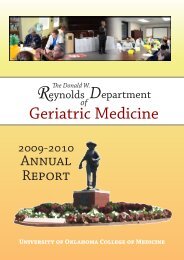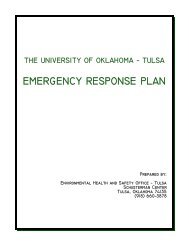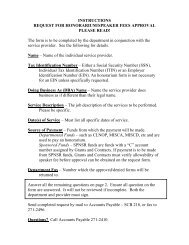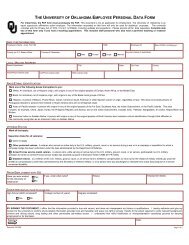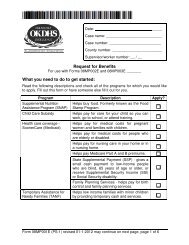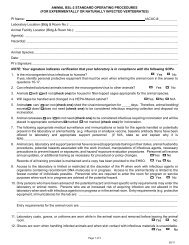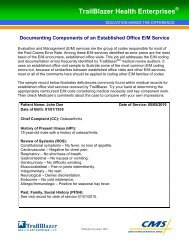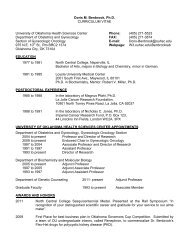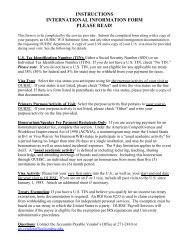The Unofficial Guide to First Year - University of Oklahoma Health ...
The Unofficial Guide to First Year - University of Oklahoma Health ...
The Unofficial Guide to First Year - University of Oklahoma Health ...
You also want an ePaper? Increase the reach of your titles
YUMPU automatically turns print PDFs into web optimized ePapers that Google loves.
UNOFFICIAL GUIDE<br />
vulnerability <strong>of</strong> the elderly <strong>to</strong> alcohol, the definition <strong>of</strong> “a drink”, the trends and<br />
percentages <strong>of</strong> different populations, and the risk fac<strong>to</strong>rs for drinking in the elderly.<br />
Dr. Rudeen – Fetal Alcohol Syndrome: HOLY CRAP these questions can<br />
sneak up on you if you aren’t prepared. She is very passionate about her work.<br />
She really emphasizes the points she wants you <strong>to</strong> take home from her lecture.<br />
Know exactly what she says in class and you won’t miss a single question on her part <strong>of</strong><br />
the exam. Know that physicians are the only ones that can diagnose FAS, the fac<strong>to</strong>rs<br />
associated with FAS, the physical markers <strong>of</strong> FAS children, and the secondary problems<br />
that FAS kids have.<br />
Dr. Duncan – Diversion <strong>of</strong> Controlled Substances, Meth and Narcotics: Dr.<br />
Duncan is a very good lecturer with unbelievable s<strong>to</strong>ries (go <strong>to</strong> class just for<br />
these), but there were also some problems with some <strong>of</strong> his test questions. I<br />
think the hardest thing about his lectures is picking out what’s important from<br />
masses <strong>of</strong> information. His syllabus has <strong>to</strong>ns <strong>of</strong> information, but he doesn’t<br />
follow it in class. On the last day, he tells you what <strong>to</strong> focus on for the test, but<br />
that isn’t the whole s<strong>to</strong>ry. Know the characteristics <strong>of</strong> drug seeking behavior, what<br />
physicians can do <strong>to</strong> increase or decrease it, understand the euphoria/ dysphoria graph,<br />
stages <strong>of</strong> meth highs, the damage caused by different drugs and <strong>to</strong> what parts <strong>of</strong> the brain,<br />
the dopamine pathway and its relation <strong>to</strong> drug addiction, the general structures <strong>of</strong> drugs as<br />
related <strong>to</strong> the ring structure given in class, the difference between narcotics and stimulants<br />
and example drugs. He has the most questions on exam II, some are easy, and<br />
some are not. Know this section like the back <strong>of</strong> your hand!<br />
Dr. Trautman – Marijuana, Inhalants, and Hallucinogens: Dr. Trautman may<br />
be remembered from the religion in medicine lectures <strong>of</strong> the fall. He gives an<br />
outline for the syllabus; going <strong>to</strong> class is necessary even though the lecture is<br />
rather dense. He talks about marijuana for almost the whole time and mentions<br />
the others quickly at the end, but that doesn’t mean they’re not on the test.<br />
Know all effects <strong>of</strong> marijuana. He will dispel the rumor that marijuana is not addictive<br />
and give you symp<strong>to</strong>ms <strong>of</strong> withdraw <strong>to</strong> know. Also, know the trends in males and females<br />
and ages with regard <strong>to</strong> marijuana usage and effects. Know examples <strong>of</strong> inhalants and<br />
hallucinogens he mentions in class and their effects and trends <strong>of</strong> use. Know how <strong>to</strong> ‘talk<br />
down’ a person using stimulants and hallucinogens. Know that hallucinogens have cross<strong>to</strong>lerance.<br />
Dr. Tassey – Smoking Cessation and Changing Behavior for <strong>Health</strong><br />
Improvement and Promotion: Dr. Tassey’s questions are indicative <strong>of</strong> what was<br />
discussed in class. Know the methods <strong>to</strong> quit smoking, which work best, which are more<br />
common, and especially the trends in <strong>to</strong>bacco use across age, race, and gender.<br />
68




